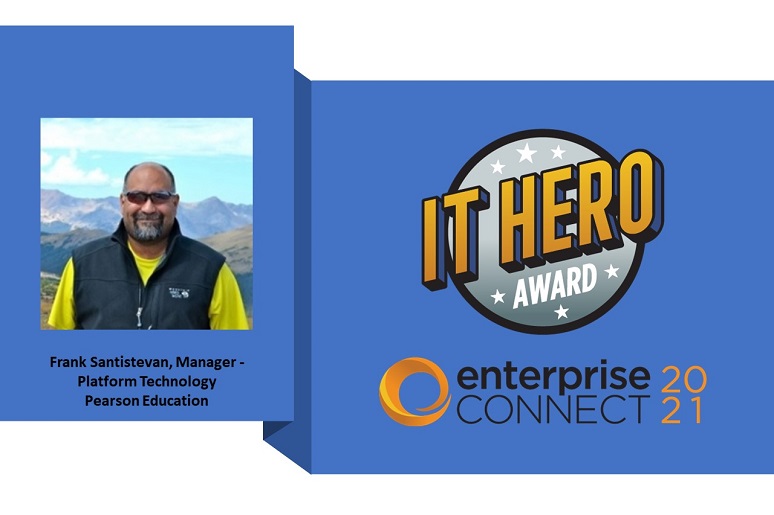Frank Santistevan, a seasoned IT professional, readily admits that he has made a career of stepping into roles and positions for which he has neither the education nor the training. Such had been the case, a few years back, when he took on responsibility for driving transformation from a premises to a cloud platform within the customer service organization at learning company Pearson Education.
At the time, Pearson itself was no stranger to the cloud. For example, the company had been and is one of the largest consumers of Amazon Web Services infrastructure and tools in the education space, and it’s a big Salesforce shop, too, as Santistevan, manager of platform technology at Pearson, noted in a recent No Jitter interview. With that backdrop, “I had seen that something desperately needed to be done differently with the contact center space, as well,” he said.
So, Santistevan said he took it upon himself to do a lot of research and lean on associates, and while everybody agreed moving into the cloud was the right direction, “interestingly enough, I’m still the only guy who stepped through the door. Most everybody else is still racking and stacking hardware and running data centers.” That Santistevan went from doing the same to spearheading a major business transformation initiative is testament to the vision and influence that earned him recognition as a 2021 Enterprise Connect IT Hero Award winner (read more IT Hero Award coverage, including profiles of additional honorees,
here).
Despite not having the skills for deploying a CCaaS environment, Santistevan said he simply went for it. “I just said, ‘You know what, let’s roll up our sleeves and get into it. I’ll surround myself with as many bright and talented people as I can and learn as much as I can from them, and then apply all those years of experience I’ve put into things, and take Pearson’s contact center technology into a new space.”
As a result of moving the contact center organization — some 5,000 agents — to a cloud platform, Pearson has saved about $1.5 million from a licensing reduction perspective, Santistevan said. But the value of CCaaS has really come to the fore during the pandemic, he added. “One of the things I had really sold this on was getting out of brick-and-mortar contact centers and letting people work in their home environments, and that’s where it’s really shone.”
While Santistevan said he has no empirical data to share, he does know that he was one of the few technology platform owners he’s aware of who was able to send agents home and, “providing they had a LAN cable and a headset,” they were working the very next day from a CCaaS platform —
CxEngage from Lifesize (previously Serenova).
As to that LAN cable, Santistevan said, “Yeah, I’m enough of an old-school guy that I still have a semi mistrust of Wi-Fi connections, so I always say, ‘Sorry, you’re going to have to run a 25-foot cable to your router or your modem’” — and, yes, sometimes that does require helping people figure out the difference between that device and a Wi-Fi hotspot, he said, laughingly. And, he emphasized, this isn’t to say that CxEngage won’t work with a Wi-Fi connection, but rather that testing and isolating problems works better on a LAN connection than a wireless one and so that’s his preference.
With contact centers around the globe, that seamless transition from contact center to home repeated itself over a two- to three-week period, he added. Even Pearson’s outsourced contact centers in places like the Philippines fell in line with the company’s decision to send agents home, thanks to the ease of doing so with the CCaaS platform, he noted.
And here’s another “fall out of your chair” fact about Pearson’s contact center transformation, Santistevan said: He handled the migration of those multiple thousands of agents with just four or five people on his team. Today, his team has roughly doubled, to 10, to address the needs of this 24/7/365 business operation. His team comprises a couple of onshore admins, a business analyst, an architect, and a few developers offshore. “We’re a very lean, mean machine.”
With such a small team, Santistevan said he’s taken an “in-the-trenches” style of management. By that, he said he likes to work next to people to understand what they’re doing so that if something goes awry, he knows what they’re talking about when they explain it to him. Once he feels he has a good understanding, he steps back. “I expect them to know their jobs, be adults, and get things done,” he said. But he also checks in regularly, especially to touch base on their mental state given the pandemic and all the social unrest of 2020 — and, of course, the workload. “I don’t want to overload my high performers because that can be a tendency as well.”
Despite getting into CCaaS without much cloud platform know-how and running the contact center technology with such a small team, Santistevan is relentless in his pursuit of what’s best for his operation, according to the IT Hero Award nomination submitted by partners at Lifesize. Toward that end, Santistevan said he’s spent a good chunk of the last couple of years focused on fine-tuning the platform to get the functionality he needed from it.
Among his marching orders for Lifesize was to square away reporting, improve data consistency, and strengthen the APIs for CxEngage, Santistevan said. While admitting to having taken some black eyes from the business for data and reporting shortfalls early on in the transition to CCaaS, he stressed the importance of working with the vendor to get things right. Years ago, from his business mentors, Santistevan said he learned the value of building relationships — and that’s something he has worked hard at doing with his contact center vendor. “I try to build a trusted relationship, so they’ll want to run through a cinderblock wall for me, because they know I’ll do that for them, as well.”
Moving forward is always on his mind, too, and he’s constantly poking colleagues, such as the Salesforce team, and his contact center partner, Lifesize, saying, “This is where I think we need to be going based on best-in-class practices that I’m observing from my associates. How do we get there?” More specifically, with the cloud, he added, the question is about getting to the future with the current provider, “because I’ve got Amazon Connect telling me they can do it for me tomorrow morning.”










